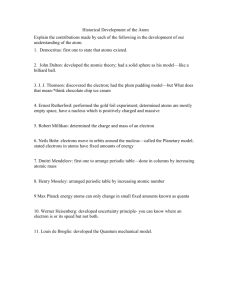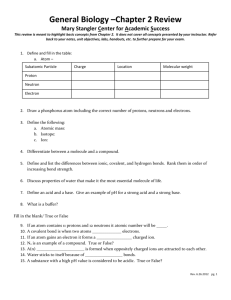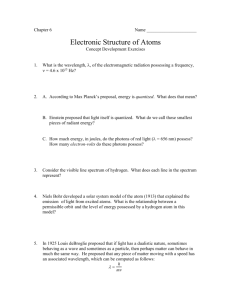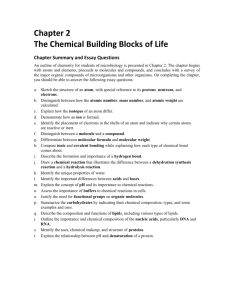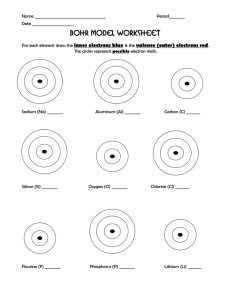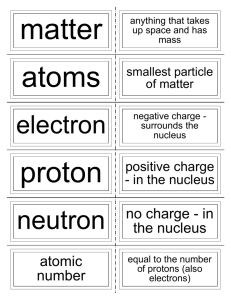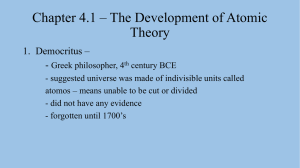Unit 1 - SharpSchool
advertisement
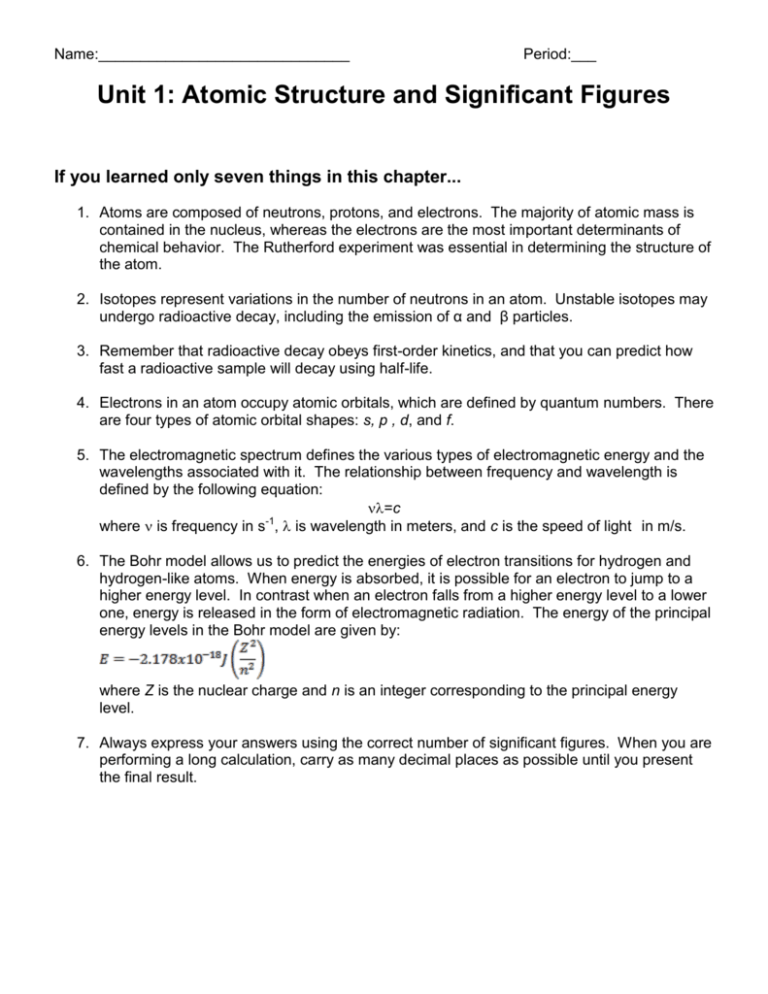
Name:______________________________ Period:___ Unit 1: Atomic Structure and Significant Figures If you learned only seven things in this chapter... 1. Atoms are composed of neutrons, protons, and electrons. The majority of atomic mass is contained in the nucleus, whereas the electrons are the most important determinants of chemical behavior. The Rutherford experiment was essential in determining the structure of the atom. 2. Isotopes represent variations in the number of neutrons in an atom. Unstable isotopes may undergo radioactive decay, including the emission of α and β particles. 3. Remember that radioactive decay obeys first-order kinetics, and that you can predict how fast a radioactive sample will decay using half-life. 4. Electrons in an atom occupy atomic orbitals, which are defined by quantum numbers. There are four types of atomic orbital shapes: s, p , d, and f. 5. The electromagnetic spectrum defines the various types of electromagnetic energy and the wavelengths associated with it. The relationship between frequency and wavelength is defined by the following equation: =c where is frequency in s-1, is wavelength in meters, and c is the speed of light in m/s. 6. The Bohr model allows us to predict the energies of electron transitions for hydrogen and hydrogen-like atoms. When energy is absorbed, it is possible for an electron to jump to a higher energy level. In contrast when an electron falls from a higher energy level to a lower one, energy is released in the form of electromagnetic radiation. The energy of the principal energy levels in the Bohr model are given by: where Z is the nuclear charge and n is an integer corresponding to the principal energy level. 7. Always express your answers using the correct number of significant figures. When you are performing a long calculation, carry as many decimal places as possible until you present the final result. Unit 1: Atomic Structure and Significant Figures Book Questions Chapter 1 Read pages 1 - 30 Complete Practice Problems (p31 - 33): 4, 6, 8, 20, 22, 24, 28, 32, 36, 40, 48, 60, 68, and 70 4. You have two beakers. One filled to the 100 ml mark with sugar (the mass is 180g) and the other filled to the 100 ml mark with water. You pour all the sugar and water together and stir until all the sugar is dissolved. a.) What is the mass of the mixture? b.) What is the volume of the mixture in relation to 200 ml? 6. If you place a glass rod over a burning candle, the rod appears to turn black. What is happening to each of the following ( physical change, chemical change, or neither)? Explain each answer. a.) the wax b.) the wick c.) the rod 8. See text 20. A student performed an analysis of a sample for its calcium content and got the following results: 14.92% 14.91% 14.88% 14.91% The actual amount of calcium in the sample is 15.70%. What conclusion can you draw about the accuracy and precision of these results? 22. Why is the separation of mixtures into pure and relatively pure substances so important when performing a chemical analysis? 24. Which of the following are exact numbers? a. There are 100 cm in a meter. b. one meter equals 1.094 yards c. We can use the equation F = 9/5C + 32 to convert from celcius to fahrenheit. Are the numbers 9/5, and 32 exact or inexact? d. = 3.1415927 28. Use exponential notation to express the number 480 to a.) one significant figure b.) two significant figures c.) three significant figures d.) four significant figures 32. Perform the following mathematical operations and express the results in the correct number of significant figures. a.) 6.022 x 1023 x 1.05 x 102 b.) 6.626 x10 34 2.998 x108 2.54 x10 9 c.) 1.285 x 10-2 + 1.24 x 10-3 + 1.879 x 10-1 d.) 1.285 x 10-2 - 1.24 x 10-3 e.) 1.00866 1.00728 6.02205 x10 23 f.) 9.875x10 g.) 9.42 x10 9.795 x10 2 100 (100 is exact ) 9.875 x10 2 2 2 8.234 x10 2 1.625 x10 3 3 (3 is exact ) 36. Perform the following unit conversions. a. 908 oz to kilograms c. 125ml to quarts e. 4.48 lb to grams 48. If the temperature in a room is 74F, what is the temperature on the Celsius scale? On the Kelvin scale? 60. The density of pure silver is 10.5 g/cm3 at 20C. if 5.25 g of pure silver pellets is added to a graduated cylinder containing 11.2 mL of water, to what volume level will the water in the cylinder rise? 68. Classify each of the following as a mixture or a pure substance. a. Water b. Blood c. the oceans d. iron e. brass f. uranium g. wine h. leather i. Table salt (NaCl) 70. The properties of a mixture are typically averages of the properties of its components. The properties of compound may differ dramatically from the properties of the elements that combine to produce the compound. For each process described below, state whether the material being discussed is most likely a mixture or a compound, and state whether the process is a chemical change or a physical change. a. An orange liquid is distilled, resulting in the collection of a yellow liquid and a red solid. b. A colorless, crystalline solid is decomposed, yielding a pale yellow-green gas and a soft, shiny, metal. c. A cup of tea becomes sweeter as sugar is added to it. Chapter 2 Read pages 41 - 73 Complete Practice Problems (p74 - 79): 12, 20, 22, 24, 26, 44, 48, 56, 58, 60, 70, and 80 12. Why do we call Ba(NO3)2 barium nitrate but we call Fe(NO3)2 iron(II) nitrate? 20.How did Rutherford’s alpha particle bombardment experiment lead away from Thomson’s plum pudding model? 24.The two most reactive families are the halogens and the alkali metals. How do they differ in their reactivities? 26. A reaction of 1 liter of chlorine gas with 3 liters of fluorine gasyields 2 liters of a gaseous product. All gas volumes are at the same temperature and pressure. What is the formula of the gaseous product? 44. How many protons and neutrons are in the nucleus of each of the following atoms? In a neutral atom of each element, how many electrons are present? a.) 79Br d.) 133Cs b.) 81Br e.) 3H c.) 239Pu f.) 56Fe 48. What is the symbol of anion with 16 p+, 18 n0, and 18 e-? What is the symbol for an ion that has 16 p+, 16 n0, and 18 e-? 56. What is the trend in metallic character going across a period in the periodic table? 58. Would you expect each of the following atoms to gain or lose electrons when they form ions. What is the most likely charge for each ion? a.) Ra b.) In c.) P d.) Te e.) Br f.) Rb 60. Name each of the following compounds: a.) Hg2O b.) FeBr3 c.) CoS d.) TiCl4 70. Write the formulas. a. sodium oxide b. sodium peroxide c. potassium cyanide d. copper(II) nitrate e. selenium tetrabromide f. lead(II) sulfide g. lead(IV) sulfide h. copper(I)chloride i. gallium arsenide j. cadmium selenide k. zinc sulfide l. nitrous acid m. diphosphorus pentoxide n. dihydrogen monoxide 80. Many times errors are expressed in terms of percentage. The percent error is the absolute value of the difference of the true value and the experimental value, divided by the true value, and multiplied by 100. Percent error = true value – experimental value X 100 True value Calculate the percent error for the following measurements. a. The density of an aluminum block determined in an experiment was 2.64 g/cm 3 . (True value 2.70 g/cm3.) Chapter 7 Read pages 289 - 336 Complete Practice Problems (p336 - 344): 36, 38, 40, 42, 46, 51, 53, 56, 62, 66, 70, 78, 82, 84, 86, 88, 90, 94, and 96 36. In the hydrogen atom, what is the physical significance of the state for which n = and E = 0? 38. Many more anhydrous lithium salts are hygroscopic (readily absorb water) than are those of the other alkali metals. Explain. 40. An FM radio broadcasts at 99.5 MHz. Calculate the wavelength of the corresponding radio waves. 42. A photon of ultraviolet light possesses enough energy to mutate a strand of human DNA. What is the energy of a single UV photon and a mole of UV photons having a wavelength of 25 nm? 46. It takes 208.4 kJ of energy to remove 1 mole of electrons from a rubidium atom. How much energy does it take to remove a single electron from an atom on the surface of solid rubidium? What is the maximum wavelength of light capable of doing this? 51. Calculate the wavelength of light emitted when each of the following transitions occur in the hydrogen atom. What type of electromagnetic radiation is emitted in each transition? a. n = 3 n = 2 b. n = 4 n = 2 c. n = 2 n = 1 53. Using vertical lines, indicate the transitions from Exercise 51 on an energy-level diagram for the hydrogen atom (see figure 7.8). 56. Calculate the maximum wavelength of light capable of removing an electron for a hydrogen atom from the energy state characterized by n = 1. by n = 2. 62. Which of the following orbital designations are incorrect: 1s, 1p, 7d, 9s, 3f, 4f, 2d? 66. In defining the sizes of orbitals, why must we use an arbitrary value, such as 90% of the probability of finding an electron in that region? 78. Using only the periodic table inside the front cover of the text, write the expected ground-state electron configurations for a. the third element in Group %A. b. element number 116. c. An element with three unpaid 5d electrons d. The halogen with electrons in the 6p atomic orbitals. 82. Which of the following electron configurations correspond to an excited state? Identify the atoms and write the ground-state electron configuration where appropriate. a. 1s22s23p1 b. 1s22s22p6 c. 1s22s22p43s1 d. [Ar] 4s23d54p1 How many unpaired electrons are present in each of these species? 84. How many unpaired electrons are present in each of the following in the ground state: O, O +, O-, Os, Zr, S, F, Ar? 86. Arrange the following groups of atoms in order of increasing size. a. Rb, Na, Be b. Sr, Se, Ne c. Fe, P, O 88. Arrange the atoms in exercise 86 in order of increasing first ionization energy. 90. In each of the following sets, which atom or ion has the smallest ionization energy? a. Ca, Sr, Ba b. K, Mn, Ga c. N, O, F d. S2-, S, S2+ e. Cs, Ge, Ar 94. The electron affinities of the elements from aluminum to chlorine are –44, -120, -74, -200.4, and –384.7 kJ/mol, respectively. Rationalize the trend in these values. 96. For each of the following pairs of elements (Mg and K) (F and Cl) Pick the atom with: a. More favorable (exothermic) electron affinity. b. Higher ionization energy. c. Larger size.
